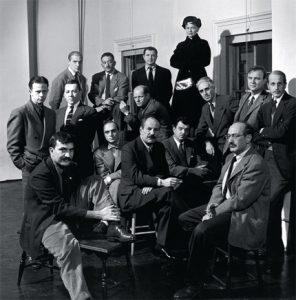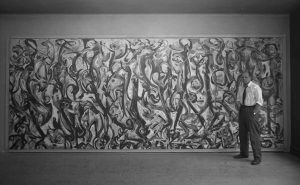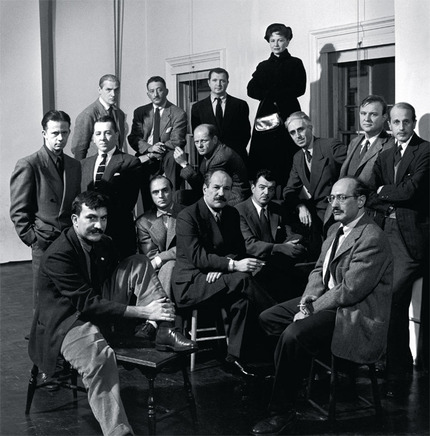
Front row, from left: Theodoros Stamos, Jimmy Ernst, Barnett Newman, James C. Brooks, Mark Rothko. Middle row: Richard Pousette-Dart, William Baziotes, Jackson Pollock, Clyfford Still, Robert Motherwell, Bradley Walker Tomlin. Back row: Willem de Kooning, Adolph Gottlieb, Ad Reinhardt, Hedda Sterne. Photo: Nina Leen/Getty Images.
The art movement, Abstract Expressionism emerged in the mid-1940s in the United States, becoming the first significant art movement to originate from the country. This style of art is characterized by an emphasis on spontaneous, free-form brushwork, non-representational forms, and an absence of recognizable images. In this article, we will delve deeper into the history, key players, and characteristics of Abstract Expressionism, and its impact on the art world.
Abstract Expressionism began in the aftermath of World War II and is considered one of the most influential art movements of the 20th century. This movement was a response to the horrors of the war and the political and social changes that followed. Artists sought to create art that reflected their emotions and thoughts on the state of the world and their individual experiences.
Some of the key figures in Abstract Expressionism include Jackson Pollock, Mark Rothko, Willem de Kooning, and Franz Kline. Jackson Pollock was known for his highly expressive, gestural paintings, often referred to as “drip paintings.” He would drip, splatter, and pour paint onto the canvas, creating unique patterns and textures. Mark Rothko, on the other hand, was known for his large, color field paintings that used simple forms and blocks of color to evoke emotions. Willem de Kooning was a pioneer in the movement, known for his abstract figures and landscapes that blended elements of surrealism and realism. Franz Kline was famous for his large, black and white abstract paintings that often used bold, gestural brushstrokes.

Jackson Pollock, Mural, 1943, oil and water-based paint on linen, 242.9 x 603.9 cm (University of Iowa Museum of Art)
Abstract Expressionism was a break from the traditional techniques of painting, as artists sought to experiment with new techniques and styles. The artists of this movement were known for their spontaneous and gestural brushwork, often using a palette knife or their bare hands to apply the paint. They sought to create art that was raw and unpolished, free from the constraints of representational forms and recognizable images.
The movement was also heavily influenced by the works of artists from the European avant-garde, such as Pablo Picasso, Georges Braque, and Joan Miró. They incorporated elements of cubism, surrealism, and Dadaism into their works, creating a new form of abstract art that was uniquely American.

Jackson Pollock standing beside Mural at Vogue Studios © Estate of Herbert Matter (Special Collections and University Archives Department, Stanford University Libraries)
Abstract Expressionism had a profound impact on the art world, influencing generations of artists and pushing the boundaries of what was considered “art.” It also helped to establish the United States as a major player in the art world, and it remains one of the most significant art movements of the 20th century.
Today, the works of Abstract Expressionist artists continue to be celebrated and revered, with exhibitions and retrospectives being held around the world. Their works are considered iconic examples of American art and are displayed in some of the world’s most prestigious museums and galleries.
In conclusion, Abstract Expressionism was a major turning point in the history of art, marking a departure from traditional techniques and a shift towards spontaneous and expressive forms. The works of its key players, such as Jackson Pollock, Mark Rothko, Willem de Kooning, and Franz Kline, remain some of the most significant and influential works of the 20th century. The movement’s impact on the art world is still felt today, as it continues to inspire and challenge artists and art enthusiasts alike.
References
“Abstract Expressionism.” The Metropolitan Museum of Art, www.metmuseum.org/toah/movements/abstract-expressionism.
“Abstract Expressionism.” The Art Story, www.theartstory.org/movement-abstract-expression


Recent Comments